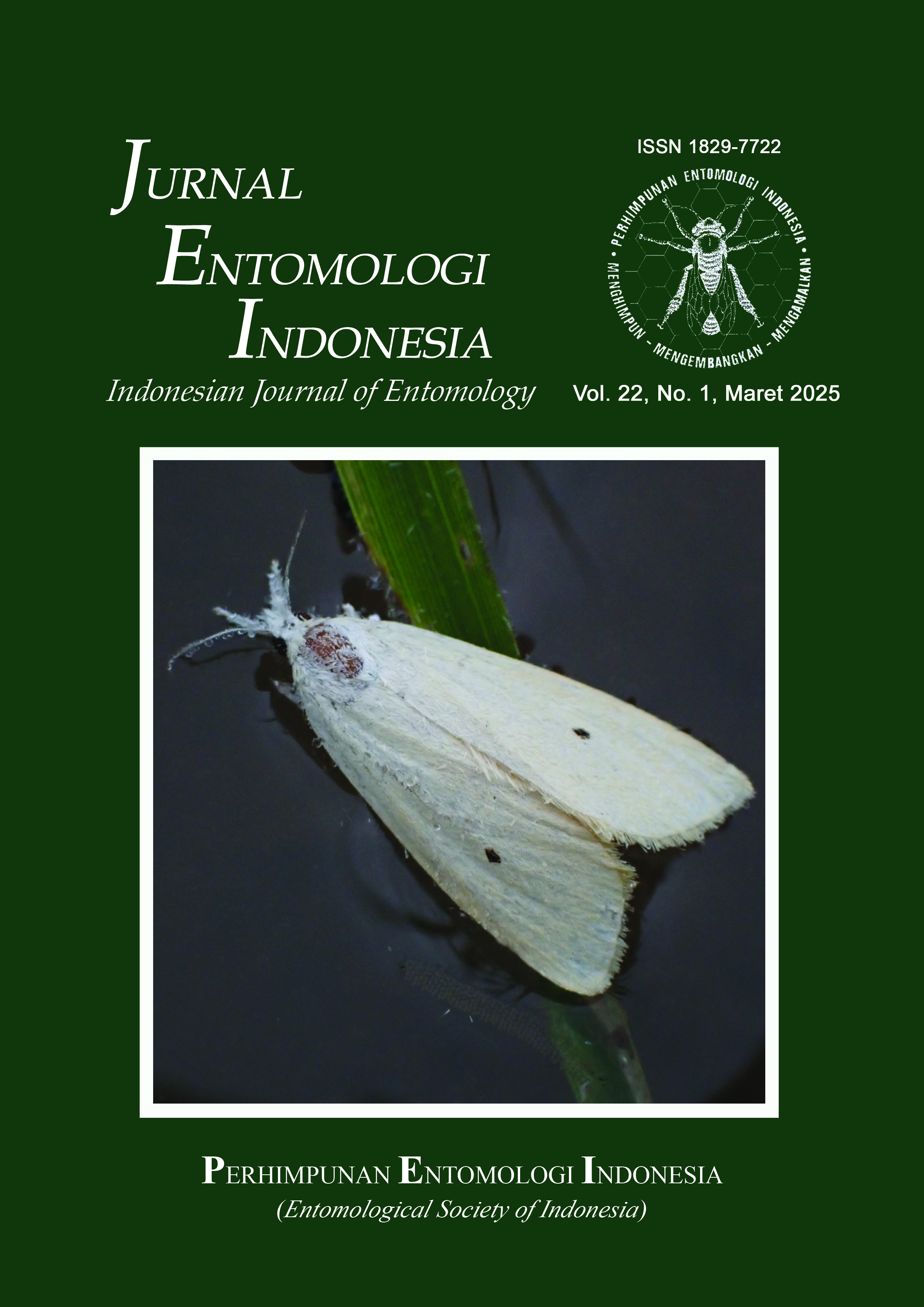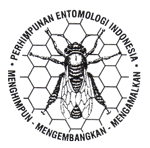Keanekaragaman strain ulat grayak jagung Spodoptera frugiperda (Smith) berdasarkan marker COI dan Tpi dengan kajian kepadatan populasi di Bali
Genetic diversity of fall armyworm Spodoptera frugiperda (Smith) strains based on COI and Tpi markers with population density analysis in Bali
DOI:
https://doi.org/10.5994/jei.22.1.41Keywords:
host strain, invasive species, mitochondrial gene, polymorphism, population densityAbstract
Spodoptera frugiperda (Smith), known as fall armyworm (FAW), originating from America that devastates corn crop, causing up to 50% damage to corn crops in Bali. Molecular identification of strain diversity using mitochondrial cytochrome oxidase subunit I gene (mtCOI) and triosephosphate isomerase gene (Tpi) markers also population density monitoring are a fundamental method for monitoring, detecting and controlling these pests. This research aims to determine FAW strain based on COI and Tpi markers and their population density analysis at representative sites in Bali. This study involved several stages: samples collection; DNA extraction; amplification, visualization; Population density observation and sequencing; and data analysis. Data were analyzed using GeneStudio and BioEdit for editing and alignment, and MEGA 11 for constructing phylogenetic tree. Sequence analysis based on COIB indicated that samples from Bali comprised of 41.67% rice strains and 58.33% corn strains, with 100% of corn strain haplotypes being h4 FAW [FL] from Florida. Based on Tpi marker, 100% of the samples were identified as corn strains with haplotypes Ca1 and Ca2. This study found that the FAW diversity in Bali consists of two strains and one haplotype based on COI (COI-R and COI-Ch4), while based on Tpi, there is only one strain with two haplotypes (Tpi-Ca1 and Tpi-Ca2). The highest population density of FAW was observed in the Tabanan plot, with 6,8 larvae/sample unit. Early instar larvae (2–3) were predominant in 3 WAP whereas late instar larvae (4–6) were predominant in 5 WAP.
Downloads
References
Acharya R, Akintola AA, Malekera MJ, Kamulegeya P, Nyakunga KB, Mutimbu MK, Shrestha YK, Hemayet JSM, Hoat TX, Dao HT, et al. 2021. Genetic relationship of fall armyworm (Spodoptera frugiperda) populations that invaded Africa and Asia. Insects. 12:1–15. DOI: https://doi.org/10.3390/insects12050439.
CABI. 2019. Spodoptera frugiperda (fall armyworm). CABI Digital Library.
Chapman JW, Williams T, Martínez AM, Cisneros J, Caballero P, Cave RD, Goulson D. 2000. Does cannibalism in Spodoptera frugiperda (Lepidoptera: Noctuidae) reduce the risk of predation? Behavioral Ecology and Sociobiology. 48:321–327. DOI: https://doi.org/10.1007/s002650000237.
Cock MJW, Beseh PK, Buddie AG, Cafá G, Crozier J. 2017. Molecular methods to detect Spodoptera frugiperda in Ghana, and implications for monitoring the spread of invasive species in developing countries. Scientific Reports. 7:4103. DOI: https://doi.org/10.1038/s41598-017-04238-y.
Dharmayanthi AB, Subagyo VNO, Nugraha RTP, Rahmini, Rahmadi C, Darmawan, Sutrisno H. 2022. Genetic characteristics and strain types of the invasive fall armyworm Spodoptera frugiperda (J.E. Smith) (Lepidoptera: Noctuidae) in Indonesia. Biodiversitas. 23:3928–3935. DOI: https://doi.org/10.13057/biodiv/d230809.
Durand K, An H, Nam K. 2024. Invasive fall armyworms are corn strain. Scientific Reports. 14:5696. DOI: https://doi.org/10.1038/s41598-024-56301-0.
Fahmi F, Kusumah RYM, Buchori D. 2023. Genetic variation of pest fall armyworm Spodoptera frugiperda (J.E. Smith) (Lepidoptera: Noctuidae) in different landscapes in Bogor. Jurnal Entomology Indonesia. 20:1–9. DOI: https://doi.org/10.5994/10.5994/jei.20.1.1.
Herlinda S, Suharjo R, Elbi Sinaga M, Fawwazi F, Suwandi S. 2022. First report of occurrence of corn and rice strains of fall armyworm, Spodoptera Frugiperda in South Sumatra, Indonesia and its damage in maize. Journal of the Saudi Society of Agricultural Sciences. 21:412–419. DOI: https://doi.org/10.1016/j.jssas.2021.11.003.
Kenis M, Benelli G, Biondi A, Calatayud PA, Day R, Desneux N, Harrison RD, Kriticos D, Rwomushana I, van den Berg J, et al. 2023. Invasiveness, biology, ecology, and management of the fall armyworm, Spodoptera frugiperda. Entomologia Generalis. 43:187–241. DOI: https://doi.org/10.1127/entomologia/2022/1659.
Lestari P, Budiarti A, Fitriana Y, Susilo F, Subawa IG, Sudarsono H, Suharjo R, Hariri AM, Purnomo, Nuryasin, Solikhin, Wibowo L, Jumari, Hartaman M. 2020. Identification and genetic diversity of Spodoptera frugiperda in Lampung Province, Indonesia. Biodiversitas. 21:1670–1677. DOI: https://doi.org/10.13057/biodiv/d210448.
Levy H, Garcia-Maruniak A, Maruniak JE. 2002. Strain identification of Spodoptera frugiperda (Lepidoptera: Noctuidae) insects and cell line: PCR-RFLP of cytochrome oxidase C subunit I gene. Florida Entomologist. 85:186–189. DOI: https://doi.org/10.1653/0015-4040(2002)085[0186:SIOSFL]2.0.CO;2.
Liang X, Zhang L, Li H, Niu X, Xiao Y. 2024. Genetic variation in the triosephosphate isomerase gene of the fall armyworm and its distribution across China. Insect Science. 31:1984–1997. DOI: https://doi.org/10.1111/1744-7917.13348.
Marín DV, Castillo DK, López-Lavalle LAB, Chalarca JR, Pérez CR. 2021. An optimized high-quality DNA isolation protocol for Spodoptera frugiperda J. E. smith (Lepidoptera: Noctuidae). MethodsX. 8:101255. DOI: https://doi.org/10.1016/j.mex.2021.101255.
Mukkun L, Kleden YL, Simamora AV. 2021. Detection of Spodoptera frugiperda (J.E. Smith) (Lepidoptera: Noctuidae) in maize field in East Flores District, East Nusa Tenggara Province, Indonesia. International Journal of Tropical Drylands. 5:20–26. DOI: https://doi.org/10.13057/tropdrylands/t050104.
Nagoshi RN. 2010. The fall armyworm triose phosphate isomerase (Tpi) gene as a marker of strain identity and interstrain mating. Annals of the Entomological Society of America. 103:283–292. DOI: https://doi.org/10.1603/AN09046.
Nagoshi RN, Goergen G, Koffi D, Agboka K, Adjevi AKM, Du Plessis H, Van den Berg J, Tepa-Yotto GT, Winsou JK, Meagher RL, et al. 2022. Genetic studies of fall armyworm indicate a new introduction into Africa and identify limits to its migratory behavior. Scientific Reports. 12:1941. DOI: https://doi.org/10.1038/s41598-022-05781-z.
Nagoshi RN, Goergen G, Plessis H Du, van den Berg J, Meagher R. 2019. Genetic comparisons of fall armyworm populations from 11 countries spanning sub-Saharan Africa provide insights into strain composition and migratory behaviors. Scientific Reports. 9:8311. DOI: https://doi.org/10.1038/s41598-019-44744-9.
Nagoshi RN, Htain NN, Boughton D, Zhang L, Xiao Y, Nagoshi BY, Mota-Sanchez D. 2020. Southeastern Asia fall armyworms are closely related to populations in Africa and India, consistent with common origin and recent migration. Scientific Reports. 10:1421. DOI: https://doi.org/10.1038/s41598-020-58249-3.
Nagoshi RN, Koffi D, Agboka K, Tounou KA, Banerjee R, Jurat-Fuentes JL, Meagher RL. 2017. Comparative molecular analyses of invasive fall armyworm in Togo reveal strong similarities to populations from the eastern United States and the Greater Antilles. PLoS One. 12:e0181982. DOI: https://doi.org/10.1371/journal.pone.0181982.
Nagoshi RN, Silvie P, Meagher RL. 2007. Comparison of haplotype frequencies differentiate fall armyworm (lepidoptera: Noctuidae) corn-strain populations from Florida and Brazil. Journal of Economic Entomology. 100:954–961. DOI: https://doi.org/10.1603/0022-0493(2007)100[954:COHFDF]2.0.CO;2.
Sartiami D, Dadang, Harahap I, Kusumah Y, Anwar R. 2020. First record of fall armyworm (Spodoptera frugiperda) in Indonesia and its occurence in three provinces. IOP Conference Series: Earth and Environmental Science. 468:012021. DOI: https://doi.org/10.1088/1755-1315/468/1/012021.
Supartha IW, Sunari AAAAS, Krisna IGPB, Yudha IKW, Mahaputra IGF, Wiradana PA. 2021a. Invasion, population development, and attack intensity of the fall armyworm (Spodoptera frugiperda) J.E Smith (Lepidoptera: Noctuidae) on two varieties corn in Serongga Village, Gianyar Regency, Bali-Indonesia. Technology Reports of Kansai University. 63:6945–6954.
Supartha IW, Susila IW, Sunari AAAAS, Mahaputra IGF, Yudha IKW, Wiradana PA. 2021b. Damage characteristics and distribution patterns of invasive pest, Spodoptera frugiperda (J.E Smith) (Lepidoptera: Noctuidae) on maize crop in Bali, Indonesia. Biodiversitas. 22:3378–3389. DOI: https://doi.org/10.13057/biodiv/d220645.
Yudha IKW, Supartha IW, Susila IW, Sudiarta P, Wijaya IN, Wiradana PA. 2024. New occurrence of corn and rice strains of Spodoptera frugiperda (Lepidoptera: Noctuidae) in Bali and Lesser Sunda (Indonesia): Genetic diversity, distribution, and damage. Biodiversitas. 25:1890–1900. DOI: https://doi.org/10.13057/biodiv/d250505.
Zhang L, Liu Bo, Zheng W, Liu C, Zhang D, Zhao S, Li Z, Xu P, Wilson K, Withers A, et al. 2020. Genetic structure and insecticide resistance characteristics of fall armyworm populations invading China. Molecular Ecology Resources. 20:1682–1696. DOI: https://doi.org/10.1111/1755-0998.13219.
Downloads
Published
How to Cite
Issue
Section
License
Copyright (c) 2025 Dheya Cintya Monica, Yayi Munara Kusumah, I Wayan Winasa

This work is licensed under a Creative Commons Attribution 4.0 International License.
Authors who publish with this journal agree to the following terms:
- Authors retain copyright and grant the journal right of first publication with the work simultaneously licensed under a Creative Commons Attribution 4.0 International License that allows others to share the work with an acknowledgement of the work's authorship and initial publication in this journal.
- Authors are able to enter into separate, additional contractual arrangements for the non-exclusive distribution of the journal's published version of the work (e.g., post it to an institutional repository or publish it in a book), with an acknowledgement of its initial publication in this journal.
- Authors are permitted and encouraged to post their work online (e.g., in institutional repositories or on their website) prior to and during the submission process, as it can lead to productive exchanges, as well as earlier and greater citation of published work (See The Effect of Open Access).








